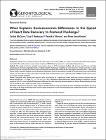| dc.contributor.author | MOORE, PATRICK | |
| dc.contributor.author | MC CRORY, CATHAL | |
| dc.contributor.author | KENNY, ROSE | |
| dc.contributor.author | Berkman, Lisa F. | |
| dc.date.accessioned | 2020-03-10T16:29:01Z | |
| dc.date.available | 2020-03-10T16:29:01Z | |
| dc.date.issued | 2017 | |
| dc.date.submitted | 2017 | en |
| dc.identifier.citation | McCrory, C., Berkman, L., Moore, P.V., & Kenny, R.A., What Explains Socioeconomic Differences in the Speed of Heart Rate Recovery to Postural Challenge?, Journals of Gerontology: Medical Sciences, 72, 12, 2017, 1717 - 1723 | en |
| dc.identifier.other | Y | |
| dc.identifier.uri | https://academic.oup.com/biomedgerontology/article/72/12/1717/3603531 | |
| dc.identifier.uri | http://hdl.handle.net/2262/91755 | |
| dc.description | PUBLISHED | en |
| dc.description.abstract | Background:
Much recent work has focused on the value of heart rate recovery (HRR) as a marker of cardiovascular health and a predictor of mortality. This article explores socioeconomic variation in HRR following exposure to a potent physiological stressor.
Methods:
The sample involved a nationally representative cohort of 4,475 community-dwelling older persons aged 50 years and older participating in the Irish Longitudinal Study on Ageing (TILDA). Participants completed an active stand (ie, vertical stand from a supine position) as part of a detailed clinic-based cardiovascular health assessment. Beat-to-beat HRR to standing was monitored over a 2-minute time horizon using a finometer. Highest level of educational achievement served as the indicator variable for socioeconomic status and mediation analysis was undertaken to explore the pathways through which social inequality comes to affect the speed of HRR using the extensive array of covariates available in TILDA.
Results:
Participants with primary level education were characterized by a significantly slower HRR after standing compared with the tertiary educated (B = −1.15 bpm, CI95 = −1.78, −0.52; p < .001). Mediation analysis revealed that lifetime smoking accounted for a sizeable proportion (40.4%) of the educational differential. Adjustment for other objectively measured markers of lifestyle measured during the clinic visit accounted for only a small proportion (5.2%) of the difference.
Discussion:
Smoking may represent a major pathway through which the social environment becomes biologically embedded in the tissues and organs of the body precipitating earlier vascular ageing among more socially disadvantaged groups, emphasizing the need to address the causes of these inequalities | en |
| dc.format.extent | 1717 | en |
| dc.format.extent | 1723 | en |
| dc.language.iso | en | en |
| dc.relation.ispartofseries | Journals of Gerontology: Medical Sciences; | |
| dc.relation.ispartofseries | 72; | |
| dc.relation.ispartofseries | 12; | |
| dc.rights | Y | en |
| dc.subject | Socioeconomic status | en |
| dc.subject | Heart rate recovery | en |
| dc.subject | Autonomic function | en |
| dc.subject | Smoking | en |
| dc.subject | Orthostasis | en |
| dc.title | What Explains Socioeconomic Differences in the Speed of Heart Rate Recovery to Postural Challenge? | en |
| dc.type | Journal Article | en |
| dc.contributor.sponsor | Health Research Board (HRB) | en |
| dc.contributor.sponsor | Health Research Board (HRB) | en |
| dc.type.supercollection | scholarly_publications | en |
| dc.type.supercollection | refereed_publications | en |
| dc.identifier.peoplefinderurl | http://people.tcd.ie/moorep3 | |
| dc.identifier.peoplefinderurl | http://people.tcd.ie/mccrorc | |
| dc.identifier.peoplefinderurl | http://people.tcd.ie/rkenny | |
| dc.identifier.rssinternalid | 157977 | |
| dc.identifier.doi | https://doi.org/10.1093/gerona/glx060 | |
| dc.rights.ecaccessrights | openAccess | |
| dc.contributor.sponsorGrantNumber | ICE/2011/7 | en |
| dc.contributor.sponsorGrantNumber | (ICE/2012/7 | en |
| dc.relation.doi | https://doi.org/10.1093/gerona/glx060 | en |
| dc.relation.cites | Cites | en |
| dc.subject.TCDTheme | Ageing | en |
| dc.subject.TCDTag | AUTONOMIC FUNCTION | en |
| dc.subject.TCDTag | Heart rate recovery | en |
| dc.subject.TCDTag | Orthostasis | en |
| dc.subject.TCDTag | SMOKING | en |
| dc.subject.TCDTag | SOCIO-ECONOMIC STATUS | en |
| dc.status.accessible | N | en |




